 Needs Pictures: 0
Needs Pictures: 0
Results 46 to 60 of 66
-
31st March 2024, 02:02 AM #46

Arms - part 1
The key piece is the top rail, and the key element here is the rear curve. Here it is smoothed on the belt sander. It will be a reference side for marking curves ...

The angles I have had to guestimate have been the tilt, front and rear, of the top rail. This is what I came up with ...
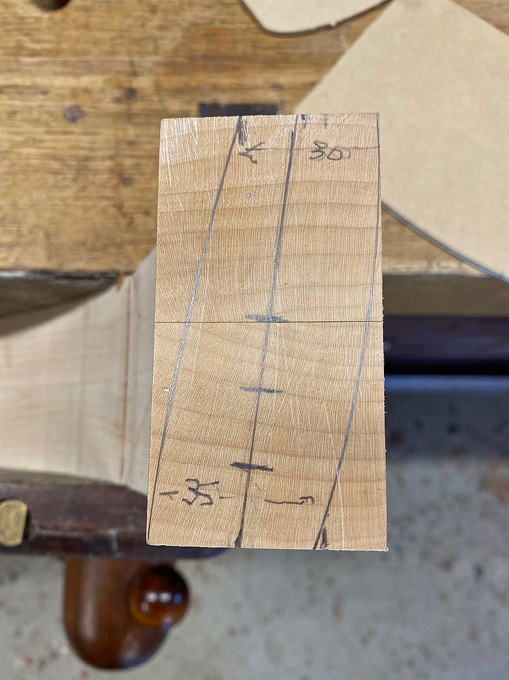
The plan is to join the arms using dowels. The Rule of Thirds applies. 3 x 3/8" dowels (3/8" = 9.5mm, which is close to the 10mm tenons used previously). Why dowels? Because they are easier to position accurately without a reference edge.
Since a large amount of waste will be removed from the top rail and arms, through shaping, the dowels need to be positioned where they will not be cut into. The three marks on the ends of the top rail are the position for the dowels. The wooden block was a quick guide to drill vertical as it needed to be done freehand ..

The only complication was that I had 6mm dowel centre points. It would have been easier if they were 3/8". Nevertheless ...


Drilled for 3/8" dowels in Jarrah (I have a bucket of them), each close to 50mm (2") in length.


Everything is still a rectangle at this stage ...

The inside face of the top rail is shaped ...

It is at this point that I have a re-think about the curve of the rear - it is not a fair curve and enough curve when compared with the photos of the DC 09 chair. The re-drawn curve on the left looks correct to me now, and this is what we will go with ...

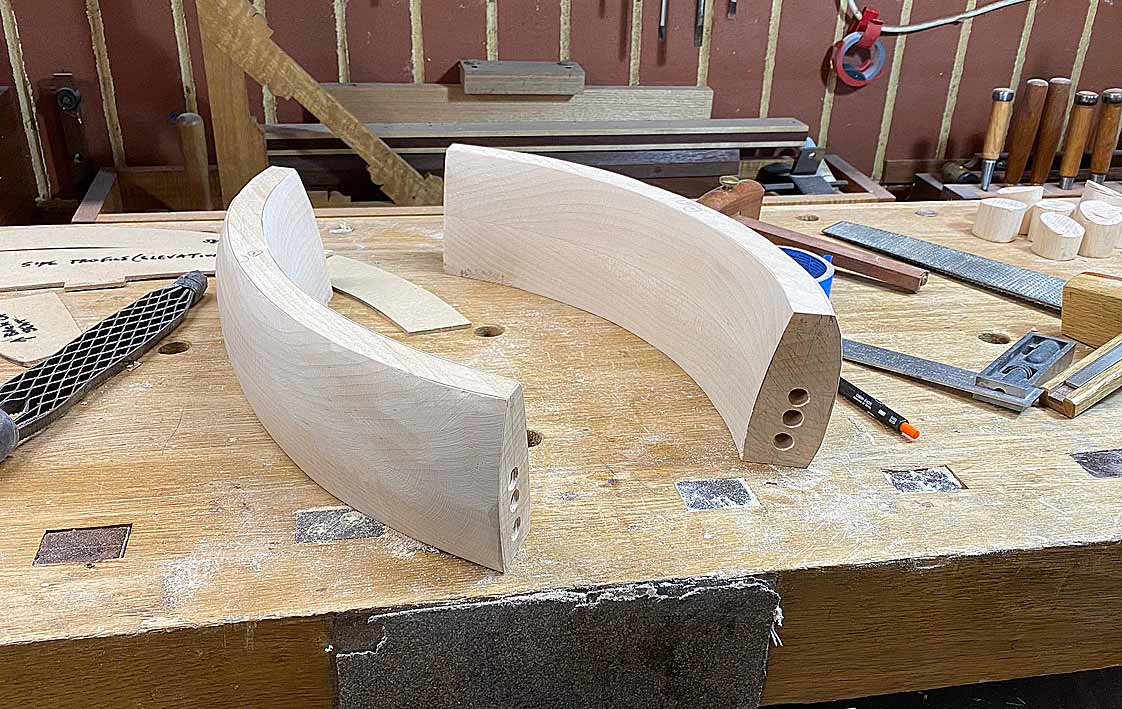
The parts are joined up as a loose fit (using undersized dowels)...
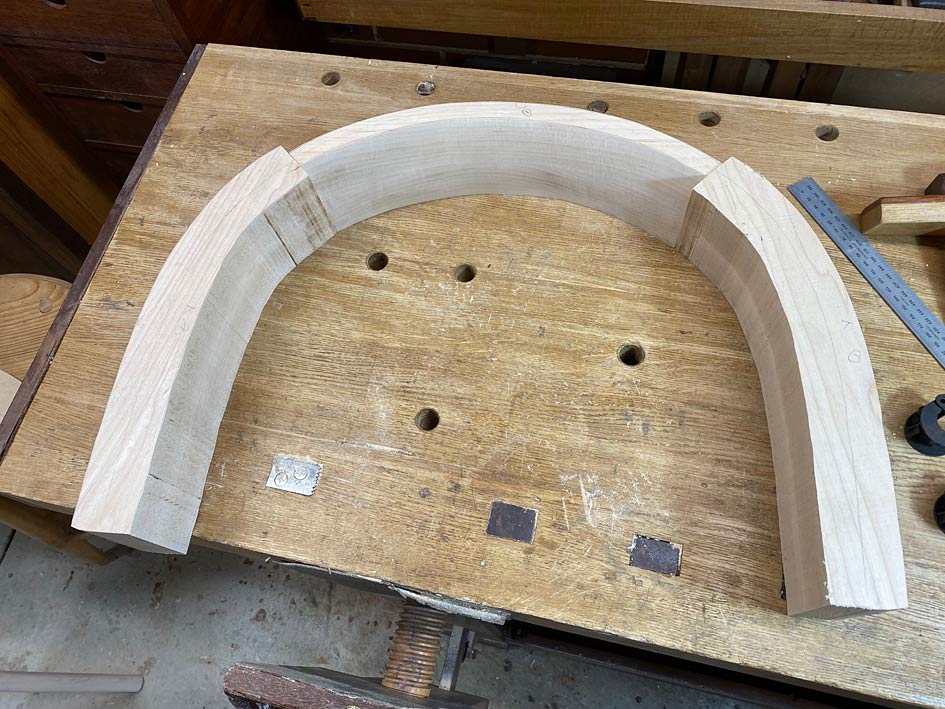
The arm/rail combination is now placed on the arm supports and adjusted to the front and rear to determine the rear overhang and position for the front joint ..

The template I made up earlier is used to trace out the side elevations. The shaping here is approximate. The main goal is to establish the length of the arms and from arm support joint ...

A little detail of interest: the height cut is slightly more than the front joint triangle would suggest as the final shaping requires a little extra meat to end in a curve ...


This is now sawn to shape, except for the underside of the arm, as the mortise/tenon area needs to be determined separately for each arm ...

Tomorrow will begin the final shaping and, hopefully, glue up of the arms.

Regards from Perth
DerekVisit www.inthewoodshop.com for tutorials on constructing handtools, handtool reviews, and my trials and tribulations with furniture builds.
-
31st March 2024 02:02 AM # ADSGoogle Adsense Advertisement
- Join Date
- Always
- Location
- Advertising world
- Posts
- Many
-
1st April 2024, 01:10 AM #47

A little more as it is getting closer.
The first step is to align all the arms and mortices ...

There was a lot of scribing, fitting, scribing and more fitting.
Finally the shaping of the underside of the arms was possible as it was now possible to determine the general position of the mortises.

The waste was removed with a bandsaw and coping saw ..

Now the specific position for the mortices was fixed with dowel pointers ...

Drilled and dowelled ..

And the arms fitted to check that all will fit at the end ...

Shaping to come.
Regards from Perth
DerekVisit www.inthewoodshop.com for tutorials on constructing handtools, handtool reviews, and my trials and tribulations with furniture builds.
-
1st April 2024, 07:23 AM #48

On the home run now, looks like just a lot of carving, fairing in and smoothing to goÖ but I guess you can sit in one chair while working on the other!
Nothing succeeds like a budgie without a beak.
-
1st April 2024, 11:36 AM #49

Home run, indeed. We fly off to New Zealand tomorrow for three weeks, and I have been using the Easter Weekend to get as much done as possible. Could do with a sit down.

Regards from Perth
DerekVisit www.inthewoodshop.com for tutorials on constructing handtools, handtool reviews, and my trials and tribulations with furniture builds.
-
1st April 2024, 01:56 PM #50
-
2nd April 2024, 01:07 AM #51

The Arms (part 2)
This is a last post before I return from three weeks being dragged over New Zealand mountains by my wife and her family. I used the Easter Weekend to get as much done as possible, but I needed a few more days. So there is more to come, later.
It is helpful to remember what the aim is - as close a copy of the DC 09 chair as possible. All guidance from photos ...
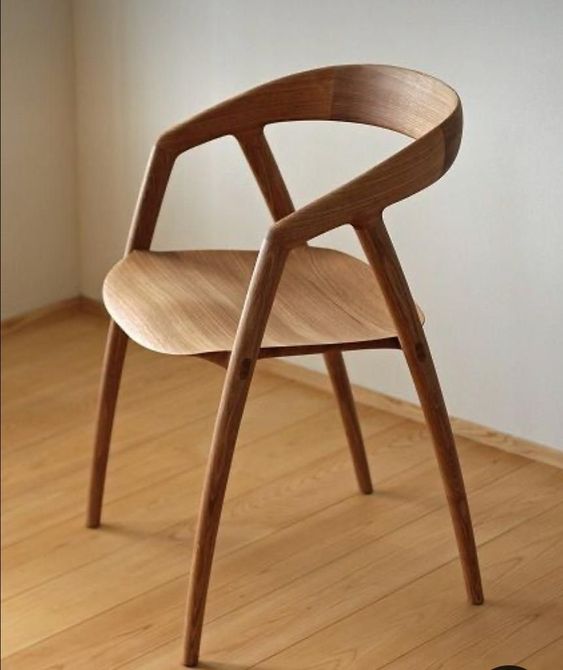
We left off here ...

The three parts that make up the arms and top rail ..

The top rails were shaped ...

And shaping started on the arms ...

Today the arms were begun.
I find it easier to do one part as far as I can take it, then stop and repeat this with another part. When all four arms have progressed the same distance, I start with the first arm again and take it to the next stage. Then the other three to match. And so on.
Each stage completed must be checked, and this is done by putting the parts together, to check that they balance. The two sides must remain a mirror image, and the two chairs must be identical. There are no templates to mark the lines to work towards, only the rough layout lines that appear fair to the eye.
The arms are shaped with rasps and spokeshaves ... mainly coarse rasps - the Shinto and a 10 grain Auriou - followed with round- and flat bottom spokeshaves. Starting with the inside faces ...

Inside faces mostly done ...
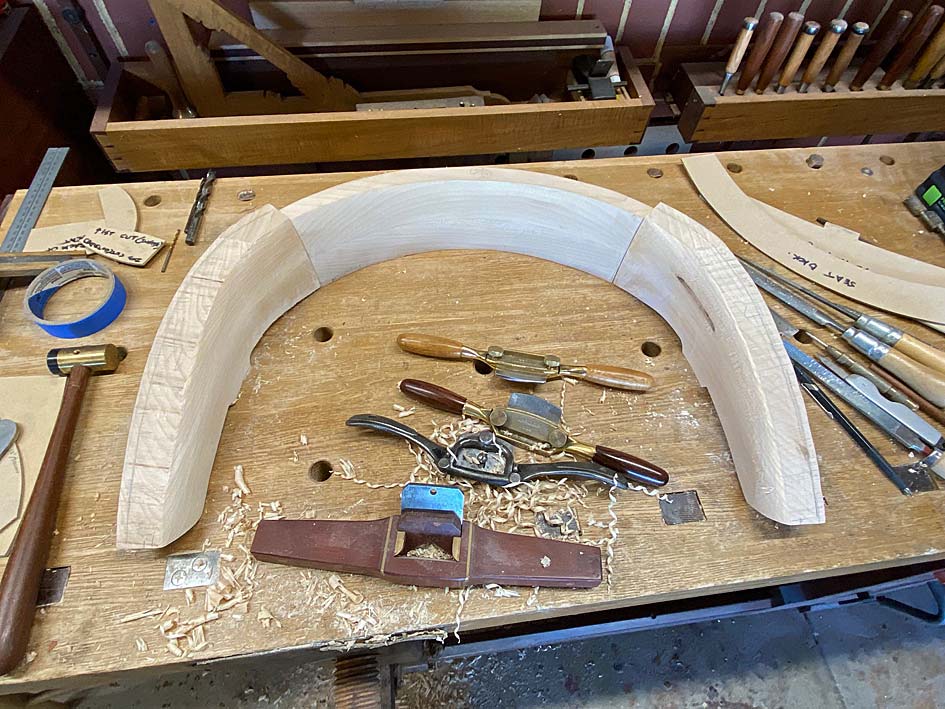
Inside faces almost done, except for the undersides ...
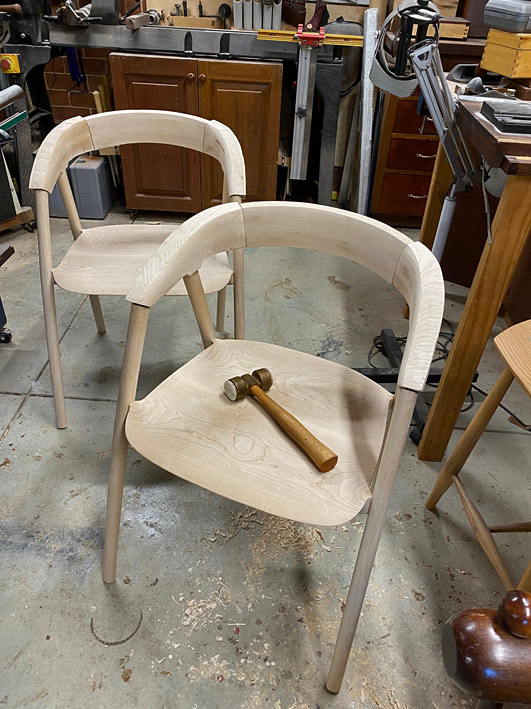
Further along - top inside and outside faces mostly done ...

And that's it for now. More later. Thanks for keeping me company through this build.
Regards from Perth
DerekVisit www.inthewoodshop.com for tutorials on constructing handtools, handtool reviews, and my trials and tribulations with furniture builds.
-
2nd April 2024, 08:25 AM #52

Just think of it as physio for your knee and enjoy the scenery!
Iím looking forward to see the process of fairing in the joints between the arms and legs; although Iíve seen many examples of the finished joint I donít think Iíve seen the construction steps.Nothing succeeds like a budgie without a beak.
-
2nd April 2024, 11:19 AM #53

Chief, this is what was the state of the Hans Wegner chair intersection, and what I expect is the case now ..
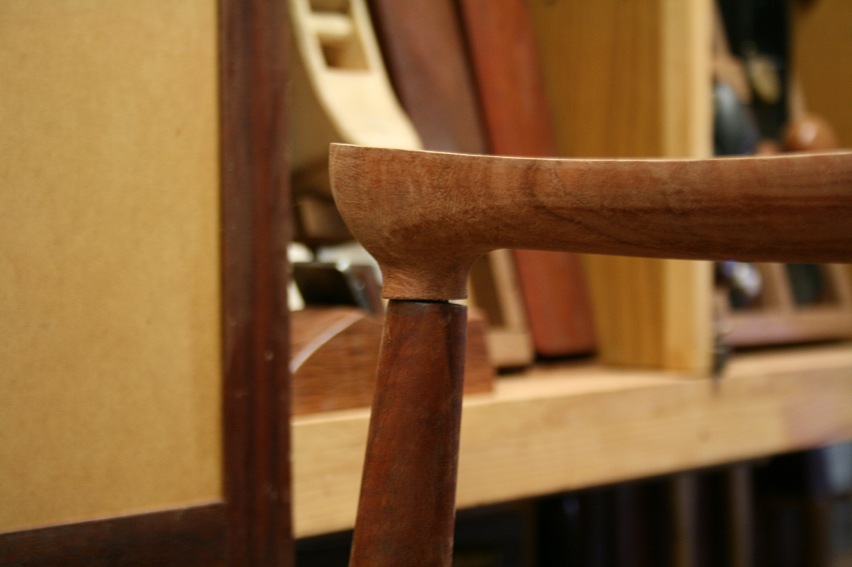
And what I expect to have to do here as well ..

Sawing inside the join (mindful that there is a tenon in there!), opening it up, and creating a kerf that becomes progressively parallel to both surfaces.
Regards from Perth
DerekVisit www.inthewoodshop.com for tutorials on constructing handtools, handtool reviews, and my trials and tribulations with furniture builds.
-
7th April 2024, 08:47 AM #54

Comment on the grain direction
One point I have not drawn attention to, but was important for me, is the grain direction throughout this build.
If you look at the arms and legs, the grain has all been oriented so that the blanks are quarter sawn. For example, the arms will show the long side grain when looking at them fron the side, as will the legs. The figured sides face the top, are carved away, and therefore the figure is minimised. The aim is to present a clear, uncluttered grain, and this should emphasise the shape/silhouette. This was not possible with the seat, and the figure was positioned as best as possible.
Regards from Perth
DerekVisit www.inthewoodshop.com for tutorials on constructing handtools, handtool reviews, and my trials and tribulations with furniture builds.
-
7th April 2024, 09:19 PM #55

Interesting; Iím building a couple of bar stools out of silky oak and while the seat and upper stretchers are quarter sawn to show off the figure I purposely selected rift-sawn sections for the legs and lower stretchers for a similar reason. The grain on the legs will be seen on two sides at a time so having one side face grained and the other one side grain will just look odd; as rift sawn blanks tend to look the same on all four sides I thought that would look better overall.
Nothing succeeds like a budgie without a beak.
-
24th April 2024, 01:17 PM #56
 A Little Aside before Derek Returns
A Little Aside before Derek Returns
Derek is due back from New Zealand very soon now.
One of my favourite designer/makers is David Haig who, coincidentally lives and works just outside Nelson, New Zealand.
He has just published an article in Australian Wood Review which discusses his approach to some of the problems Derek has been wrestling with in the build of his dining chairs.
Joining curves':' David Haig'''s method - Australian Wood Review
Photo - David Haig and AWR
-
24th April 2024, 10:49 PM #57

Thanks Graeme. I shall have a read.
Back home!
Regards from Perth
DerekVisit www.inthewoodshop.com for tutorials on constructing handtools, handtool reviews, and my trials and tribulations with furniture builds.
-
28th May 2024, 02:32 AM #58

Back on the job after 3 weeks hiking mountain trails in the South Islands of New Zealand, then returning home with Bronchitis (although I was wearing a mask on the plane, passengers preferred to sit with the crying babies than listen to me cough and wheeze!). A few more weeks to recover. First day in the workshop this weekend.
First task was to glue the arms sections together. You will recall that they are reinforced with dowels.

In a similar build, where the sections needed to be clamped together, it was possible to leave "ears" as the blanks were wider/thicker. I could not do that here, and so decided to epoxy these ears on ...

Well, it wasn't particularly successful, even allowing for 24 hours cure time. The ears broke off.
All I could do was clamp the ear on, and pray this would hold.
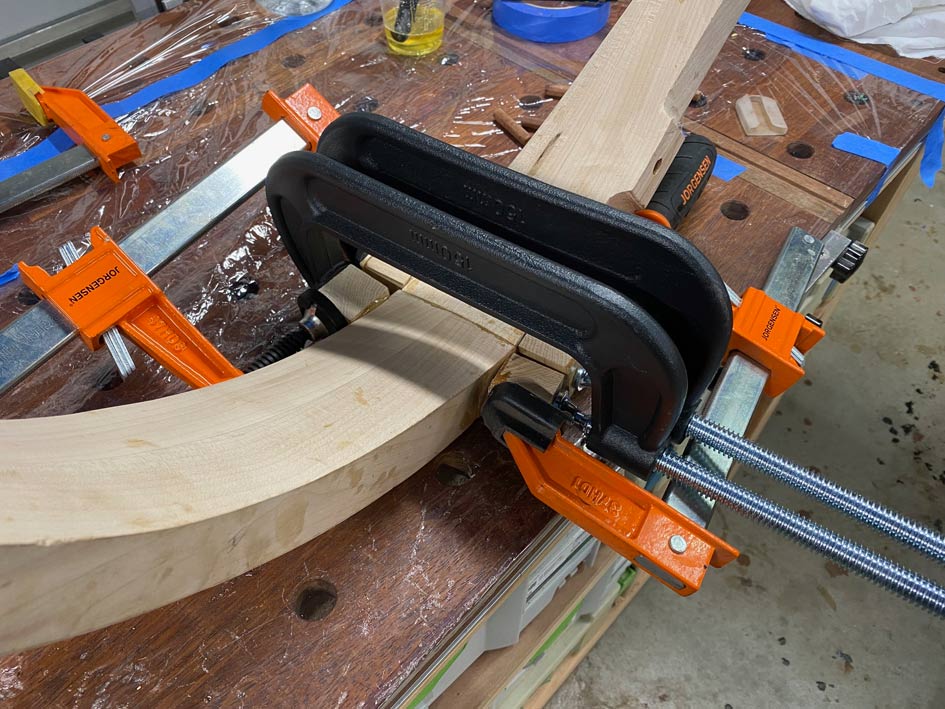
Later I realised that the problem was that the dowels I used were too tight, and the force needed to drive them home was unexpected. Lesson learned for all - if using epoxy, which is gap filling, the dowels has be a slip fit rather than a force fit. Of course, it would have been easier if I had known this beforehand!
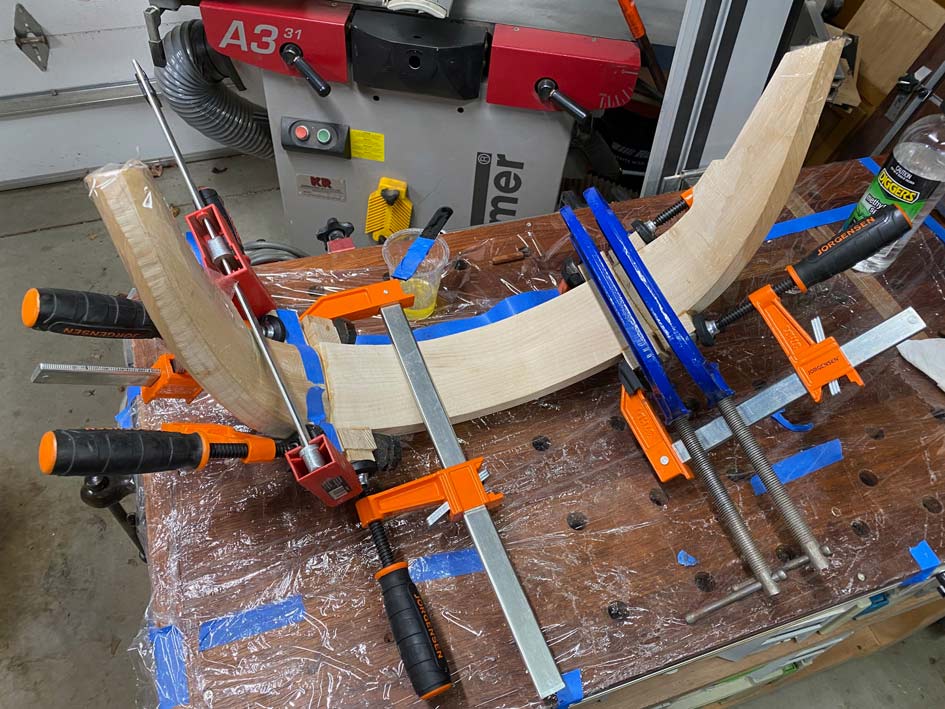
Once all was together, now in one piece (or two pieces if you count two chairs), the rasping and spokeshaving began ...
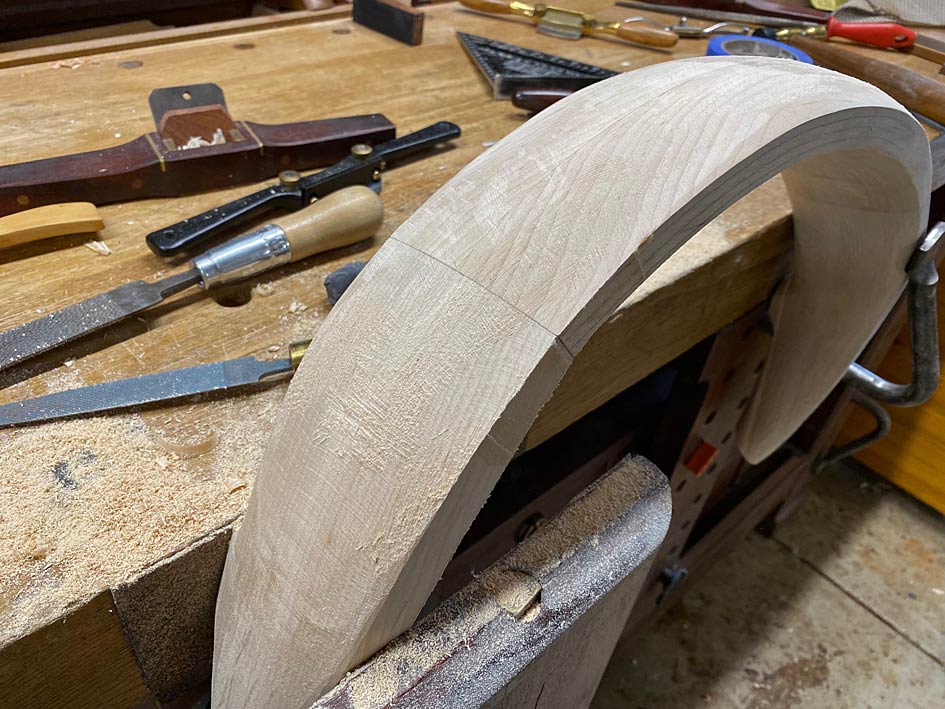
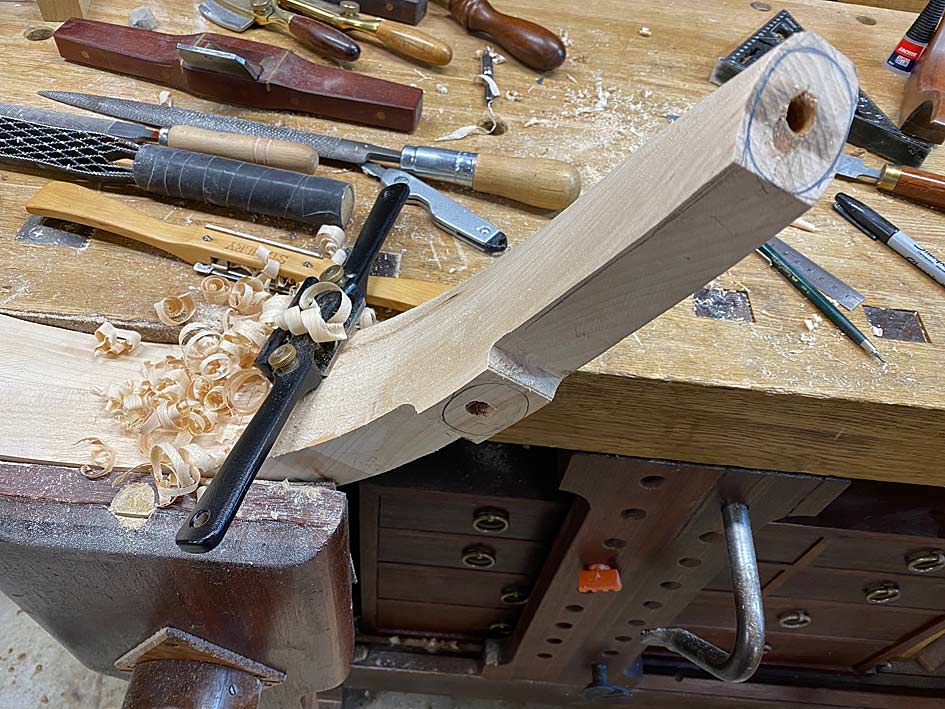
The aim now was to get the arms closer. This is all slow work, a bit here and a bit there, return to check the symmetry and shaping, and a bit more off. Work stopped to redrill the dowel holes that hold the arms to the legs. There had been a little movement while I was away, or I have measured inaccurately the at the start. It is important that the arms-legs join with as little stress to the joint as possible.
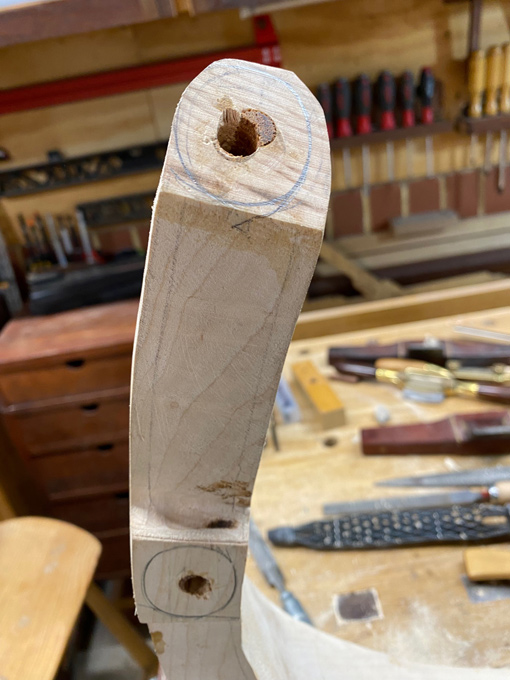
A couple of progress shots of shaping thus far - lots still to come, but its getting to look like the original chair now.
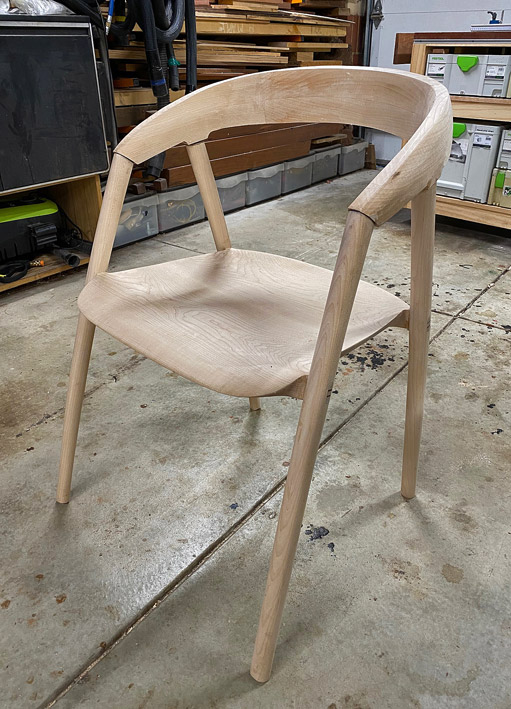
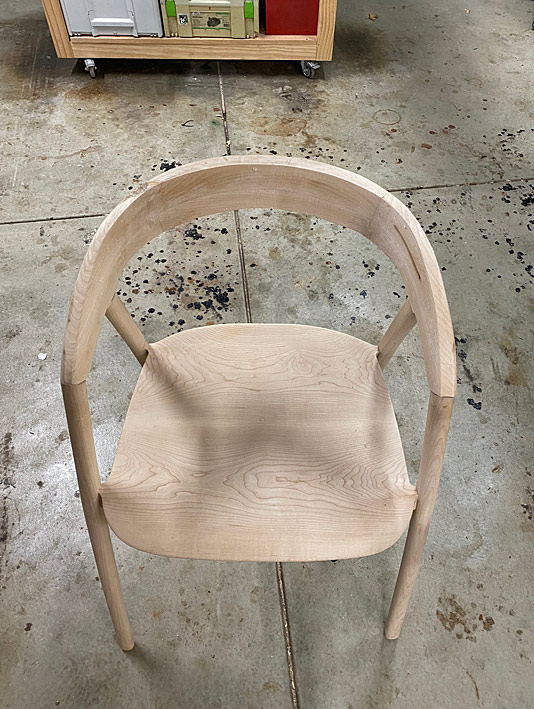
Regards from Perth
DerekVisit www.inthewoodshop.com for tutorials on constructing handtools, handtool reviews, and my trials and tribulations with furniture builds.
-
2nd June 2024, 05:09 PM #59

This is looking phenomenal mate, been very interesting reading through the progress! Hope you've recovered from the bronchitis [emoji846]
Sent from my Pixel 8 Pro using Tapatalk
-
3rd June 2024, 12:58 AM #60

I have found that the shaping of the chair arms and back to be a complicated process, with a step forward, then sideways, and then another step forwards. It is not plain sailing. There are many small corrections to make as I proceed, and I dare not attempt to leave these until a later date. I thought that some here will find the corrections ... repairs ... interesting, and hopefully useful if you find yourself in the same situation.
In the following photo, where the inside back is being shaped, you can see two joins where the arms and back connect ...

Outside example ..

These joins are clean and tight. In all there were 8 such joins, 2 chairs with each 2 inside and 2 outside joins. Of these 8 joins, 7 were perfect. One was a disaster!
What happened was, in clamping the two parts, there was movement and an outside section moved slightly. This left a gap. To make it worse - as bad as it could get - the corner of one piece was crushed by a clamp, and cracked! I pushed it back into position, secured it, but it must have moved a little. Try not to cry ...

Well, you just have to repair it. And not with filler or a wedge.
I decided to peen the wood and move it into the gap. I have used this technique for dovetails, which is edge grain, but never for end grain. In fact, I have not seen anyone do this before.
Using a couple of different size drift punches, I began tapping the wood into the gap ...

It looks like hell, but it did the job ...

I'll save the outcome for the end of the build. [wink]
In the following photo you can see areas marked in pencil. These are where waste is to be removed ...

A little is removed, and then the arms are returned to the base, where more is marked for removal ...

The shaping of the arms is completely by eye. There are no templates to guide the work done. The photos are my reference: "does it look right ... no ... take more off there ....".
I finally get to a point where I need to check whether the curve at the rear is fair. It needs to be symmetrical and fair, and the same for both chairs. Now I trace the curve of one half of the rear centre section ...
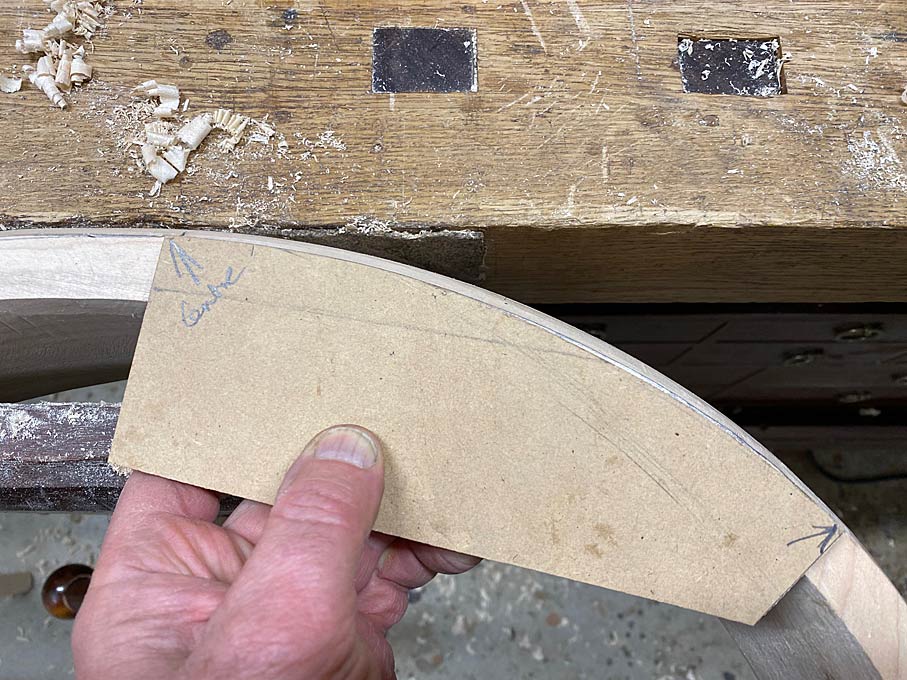
Flipping the template, this is taken to the other side of the back ..
It is just a smidgeon off ...

And the template is used on the other chair, and this proves to be identical o chair #1 ... just a smidgeon off the left side to spokeshave away ...
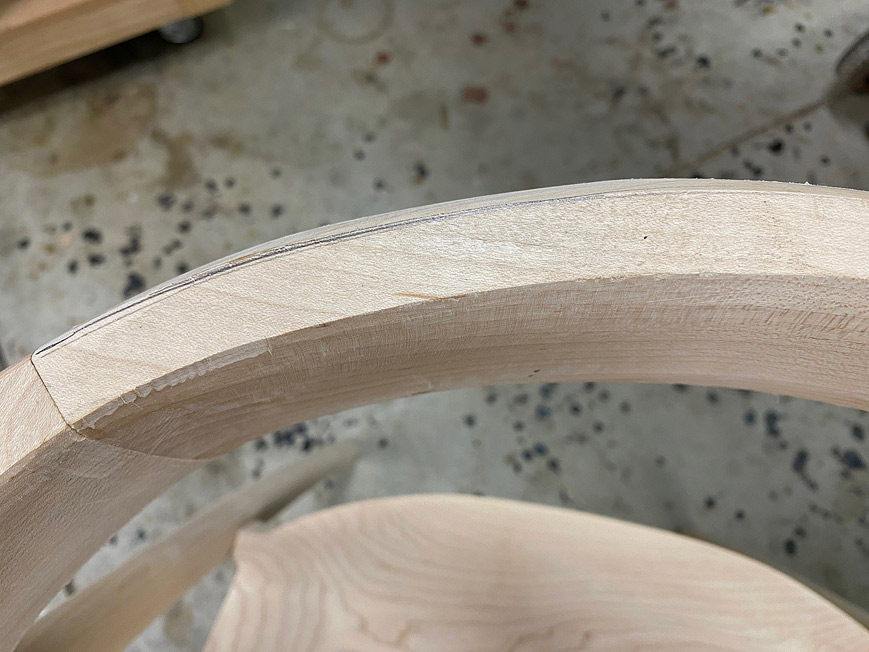
I am amazed that the shaping has remained within my tolerances all this time!
Lastly, I have been keeping an eye on the leg-arm joins. A couple were not meeting flush, and this needed to be corrected. For example, here you can see the gap. The blue tape marks where it keeps to be corrected ...

The top is covered in pencil to help see where the rasp is working, and the section that must not be touched ...

The result ...

The end of the day. A lot of work has been done over a period of 1 1/2 days in the workshop. This may go unnoticed by all but you and I ...

Lots more to do.
Regards from Perth
DerekVisit www.inthewoodshop.com for tutorials on constructing handtools, handtool reviews, and my trials and tribulations with furniture builds.
Similar Threads
-
Building dining room carver chairs
By derekcohen in forum FURNITURE, JOINERY, CABINETMAKING - formerly BIG STUFFReplies: 37Last Post: 25th January 2024, 10:01 PM -
Dining room chairs
By Template Tom in forum ROUTING FORUMReplies: 0Last Post: 18th May 2016, 06:15 PM -
dining room chairs
By Gaza in forum WOODWORK - GENERALReplies: 1Last Post: 23rd December 2007, 08:13 PM -
Dining Room Chairs
By dreinoga in forum DESIGNS & PLANS FOR PROJECTSReplies: 3Last Post: 13th November 2004, 09:28 PM -
Books on making dining-room chairs
By willy_punter in forum WOODWORK - GENERALReplies: 4Last Post: 8th June 2004, 05:21 PM



 Thanks:
Thanks:  Likes:
Likes:  Picture(s) thanks:
Picture(s) thanks: 


 Reply With Quote
Reply With Quote
